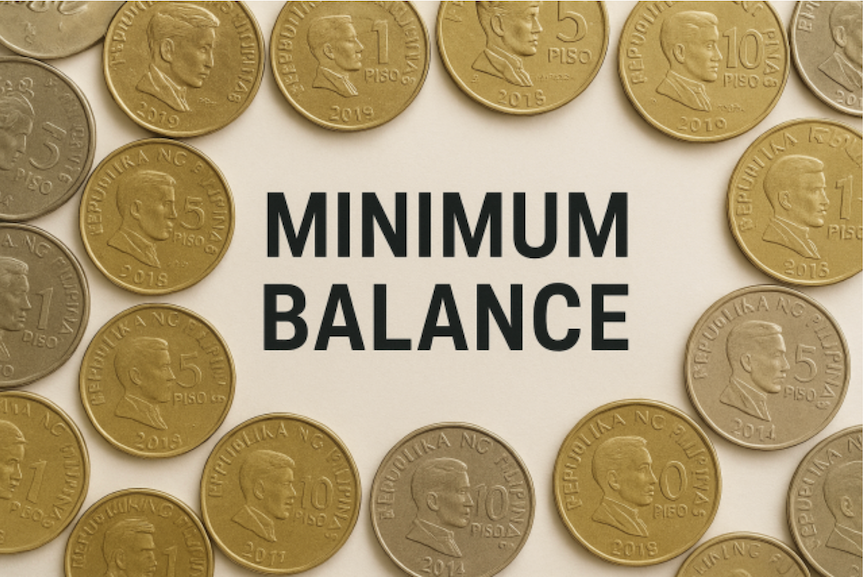In the Philippines, a lot of people encounter a term when opening a bank account that they don’t fully understand: “minimum balance.”
This article explains what it means, why it’s important, and how it impacts Filipino account holders.

What is minimum balance?
A minimum balance is the lowest amount you must keep in your bank account at all times. If your balance drops below this amount, your bank may charge a maintenance fee or, in extreme cases, close your account.
Banks impose this requirement to ensure liquidity and help cover the costs associated with maintaining the account.
In the Philippines, traditional banks and digital platforms each have different policies regarding minimum balances. Understanding these requirements can save you from unnecessary fees.
How much is the minimum balance in the Philippines?

The amount required varies depending on the bank and the type of account. Here’s what you can expect:
- Traditional banks
- For basic savings accounts, most banks require a ₱2,000 to ₱5,000 minimum balance.
- Checking accounts typically require a higher minimum balance, ranging from ₱10,000 to ₱50,000.
- Digital banks
- Specialized accounts
- Some high-interest savings or premium accounts may require a higher minimum balance, such as ₱10,000 to ₱50,000, in exchange for better benefits.
- Some high-interest savings or premium accounts may require a higher minimum balance, such as ₱10,000 to ₱50,000, in exchange for better benefits.
Why do banks require a minimum balance?
- To cover operational costs — Banks use the minimum balance to cover processing costs, account maintenance, and transaction handling. The funds help maintain liquidity and ensure the bank can function smoothly.
- To encourage account activity — Banks encourage users to keep a certain amount in their accounts, which ensures they maintain an active relationship with their bank. This leads to better customer retention and more stable account usage.
- Regulatory requirements — Minimum balance policies also help banks comply with regulations set by the Bangko Sentral ng Pilipinas (BSP), ensuring financial stability.

What happens if you don’t maintain the minimum balance?
If your account balance falls below the required amount, your bank will likely charge a monthly maintenance fee.
The fees can range from ₱100 to ₱300. Some banks may impose additional penalties if the balance remains low for extended periods. In extreme cases, banks could even close the account if the balance stays under the required minimum for too long.
Alternatives to minimum balance accounts
While traditional banks often impose high minimum balance requirements, digital-first platforms offer alternatives. Some digital banks provide zero minimum balance accounts, which makes them attractive to those who prefer more flexibility.
Here are a few options:
- GCash — offers a mobile wallet where you can store money, pay bills, and transfer funds without needing to meet a minimum balance.
- PayMaya (now Maya) — allows users to store money and access financial services with no minimum balance. It’s an excellent choice for people who prefer a simple and accessible platform.
- ING Philippines — offers a savings account with no minimum balance requirement and competitive interest rates, catering to those who want a more straightforward banking experience.
How to avoid minimum balance penalties
- Choose the right account — If maintaining a minimum balance is difficult for you, opt for a digital bank account or a low-maintenance savings account that offers more flexibility. Many digital banks are designed to be low-cost alternatives to traditional accounts.
- Set up automatic transfers — To maintain your minimum balance, set up an automatic transfer from your primary account to your savings account. This will help ensure you meet the required amount each month.
- Monitor your balance regularly — Use online banking apps to track your account balance and avoid going below the required minimum. Most banks send alerts when your balance is low, giving you time to top it up.
- Watch out for other fees — Even if you find an account with a lower minimum balance, make sure to check for any other fees such as withdrawal charges, transfer fees, or inactivity fees. Some banks may offer accounts with low minimum balance requirements but higher fees for other services.
Understanding minimum balance to avoid unnecessary fees

In the Philippines, minimum balance requirements are a key factor when choosing a bank account.
Banks use this requirement to maintain liquidity, cover operational costs, and ensure account holders remain active. Traditional banks may charge maintenance fees if the minimum balance is not met, while digital platforms offer more flexible options with no minimum balance requirements.
Understanding these policies is crucial for making the right choice for your financial needs. Whether you opt for a traditional bank or a digital platform, always read the fine print to avoid penalties and make the most of your banking experience.








